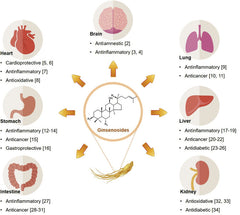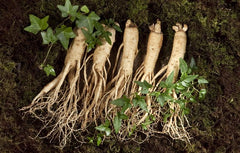Ginseng has been highly valued across Northeast Asia. Among them, Korean native ginseng has long been renowned for its outstanding efficacy and quality.
What is Korean ginseng different from other Ginsengs?
Korean ginseng is a plant that grows in Korea. It’s sometimes known as Asian ginseng, Chinese ginseng, or Panax ginseng.
Korean ginseng shouldn’t be confused with Siberian ginseng or American ginseng. Siberian and American ginseng are different plants that serve different needs.
The ginseng root is used as a natural remedy in supplement form. The plant must grow for 5 years before it’s used. This usually means that high-quality ginseng commands a high price.
The dried but unprocessed root is called white ginseng. The root that’s been steamed and dried is called red ginseng.
What is Red Ginseng different from White Ginseng?
-
Processing Method: Red ginseng is produced by drying and steaming the ginseng root, which undergoes a process of fermentation. This process enhances the bioactive compounds in red ginseng, potentially increasing its efficacy compared to raw ginseng.
-
Active Compounds: Red ginseng contains higher levels of certain active compounds such as ginsenosides, which are believed to contribute to its health benefits. These compounds are thought to have various effects on the body, including immune modulation, antioxidant activity, and improvement in cognitive function.
-
Health Benefits: Red ginseng is commonly used in traditional medicine for its potential to boost immune function, reduce stress, improve circulation, and enhance cognitive performance. Additionally, it may have anti-inflammatory properties and protect against cellular damage due to its antioxidant effects.
Red ginseng has been used for centuries in Asian cultures and is believed to offer numerous health benefits.
Traditional uses of Korean Red Ginseng
Korean red ginseng has been used in traditional Oriental medicine as an overall wellness supplement for centuries. It’s been used to:
- boost the immune system
- improve heart health
- treat diabetes
- increase energy
- decrease stress
- treat impotence

Depending on the processing method, ginseng is broadly classified into red ginseng and white ginseng. Red ginseng refers to steamed and dried ginseng, while white ginseng refers to ginseng dried without steaming or other methods. When ginseng is steamed and then dried, a browning reaction occurs, and pharmacological components that white ginseng does not possess are expressed. The original 25 types of saponin components increase to 36 types, and it's worth investigating what physiological changes these 36 types of saponin components (ginsenosides) induce.
- Immune Enhancement

The rich polysaccharide components of red ginseng activate immune cells such as T cells, B cells, and macrophages, effectively suppressing various inflammatory factors and boosting immunity. It is effective in preventing and treating respiratory infections such as colds and influenza.
- Fatigue Improvement

Red ginseng, abundant in saponin components, promotes fatigue recovery through buffering metabolic acidity associated with lactate and inhibiting glycogen utilization during prolonged exercise, thus enhancing fatigue delay and exercise performance.
- Blood Circulation Improvement

Saponin components help remove waste products and cholesterol from blood vessels, promote smooth blood flow, and inhibit the action of substances inducing platelet aggregation, expanding blood vessels and improving blood circulation. This effect helps prevent vascular-related diseases such as hypertension, arteriosclerosis, and myocardial infarction.
- Memory Enhancement

Red ginseng reduces inflammatory factors in the hippocampus, the part of the brain responsible for memory, enhancing the function of the prefrontal cortex responsible for cognitive function and movement. Additionally, it activates "alpha waves," brain frequencies associated with memory and cognitive function, thereby improving learning and memory.
- Antioxidant

Lipids and oxidants induce cellular oxidative damage, leading to functional decline, inflammation, arteriosclerosis, aging, cancer, and more. However, consuming red ginseng increases the activity of antioxidant enzymes (SOD), reducing the production of lipid peroxides and oxidized LDL cholesterol due to oxidative stress.
Note:
The ginsenoside component of red ginseng can decrease platelet aggregation and enhance the effect of lowering blood sugar. Therefore, caution should be exercised when consuming it alongside diabetes medications and anticoagulants.
The immune enhancement, fatigue improvement, blood circulation improvement through platelet aggregation inhibition, memory enhancement, and antioxidant effects introduced by red ginseng's efficacy are recognized as the 5 major functional properties of red ginseng by the Korean Food and Drug Administration. It is currently one of the most widely used health functional foods in South Korea.
Recently, amid heightened concerns about health and immunity due to the influence of COVID-19, the consumption of red ginseng products has increased among people of all ages, from children to the elderly, for health management.
Shop In Korean Red Ginseng Category
This Article was written based on Resources of The Ministry of Food and Drug Safety of Korea.






